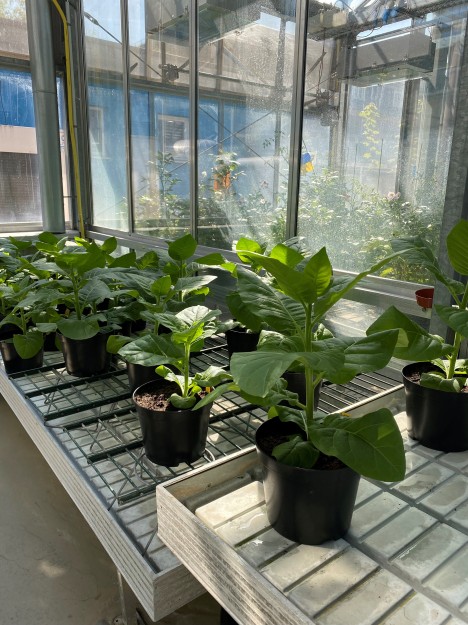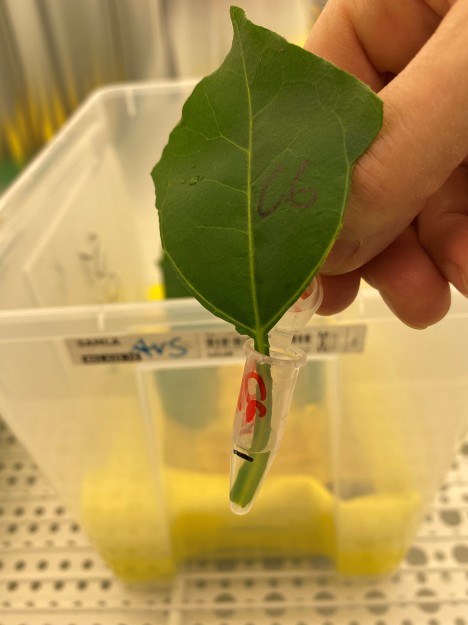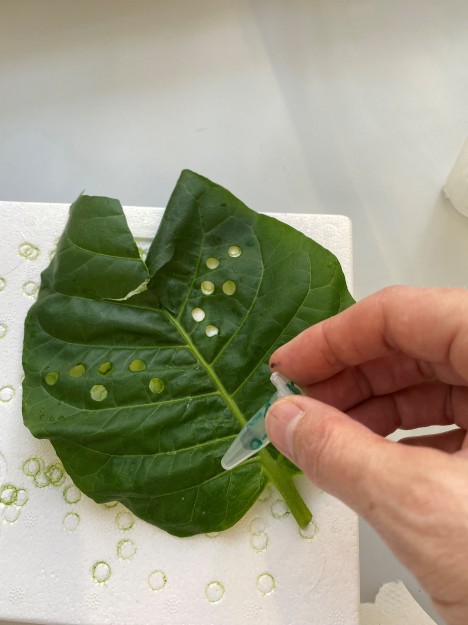
Metabolic alteration to increase the stress tolerance of tobacco plants
When there is drought, a pathogen attack, or too much salt in the soil, plants are faced with a constant series of stress factors. Plant biotechnologists study how plants cope under such circumstances, meaning, which molecular mechanisms may increase stress tolerance and, thus, how plant defence responses can be improved. A team under Prof. Antje von Schaewen at the University of Münster has been investigating genetically modified tobacco plants that produce more biomass under stressful conditions compared to non-modified relatives. The researchers followed up on the question, which molecular mechanism(s) may play a role for their findings. They could show that a subtle change in carbohydrate metabolism (resulting from enzyme replacement) causes the transgenic plants to transport more fatty acids from the leaves to the inflorescences and seeds, thus compensating for ten per cent less sugar transport. The study, which also involved scientists from the University of Göttingen (Germany) and the University of Ferrara (Italy), was recently published in the highly respected “Plant Journal”.
The tobacco plants (Nicotiana tabacum) investigated stem from the “Xanthi” variety that is routinely used by plant researchers and which Antje von Schaewen and her team created using gene modification methods in the early 2000s. The team has now been able to explain how the transgenic plants circumvent a genetically fixed compromise: to divide energy between growth and resilience to pathogens and other stress factors. In the genetically modified tobacco plants, a biochemical intermediate of carbohydrate metabolism (6-phosphogluconate) acumulates, which then leads to an elevation of the signalling molecule fructose-2,6-bisphosphate. As a result, more sugar is retained in the leaves from which more NADPH can be produced through the engineered enzyme replacement. NADPH is important for energy metabolism but also essential for the plant’s development and various stress-defence mechanisms. The scientists found five per cent more lipids in the leaves and up to 20 per cent more in the seeds.
The team was able to demonstrate that, in addition to the transport sugar sucrose, more fatty acids are transported through the nutrient-carrying vessels of these plants, i.e., over several meters from the leaves (as sites of photosynthesis) to the growing inflorescences. “Fatty acids can be transported in free form up to a chain length of 18 carbon atoms. Longer carbon chains are likely transported in bound form, attached to special carrier proteins”, explains Antje von Schaewen. “This resembles the situation in the blood of animals and humans, in which fatty acids and cholesterol are transported bound to serum albumin.” Other researchers published material hinting at such a mechanism of lipid transport via the phloem already in 2002 in a study on canola (Canadian rape seed). “We have now confirmed these results with our transgenic tobacco plants”, emphasizes Antje von Schaewen.
The research team sought to identify the molecular mechanisms that underlay the elevated stress tolerance of the “enzyme-replacement method” that they published on earlier in 2009. Motivated by this pilot study in tobacco, future research could now apply the principle to additional nightshades like potato, tomato and bell peppers using the newer CRISPR/Cas9 technique (known as gene scissors) or test whether general stress tolerance, higher yields and energy density of the seeds of other plant species, preferentially those with seeds that contain little fat, can be improved using this approach.
On the methodology: the researchers used plants of a tobacco line (Nicotiana tabacum var. Xanthi) that is especially sensitive to pathogen infection and replaced the enzyme G6PDH in the cell’s interior with a similar enzyme (P2 isoenzyme G6PD3) from non-green plastids of mouse-ear cress (Arabidopsis thaliana). G6PDH and its isoenzymes metabolize activated sugar (glucose-6-phosphate) to provide NADPH as an energy equivalent, mainly for anabolic reactions. In addition, the researchers suppressed the tobacco-endogenous isoenzymes in the cytosol using the so-called RNA interference (RNAi) technique to ensure that the observed effects result from the new cytosolic P2 isoenzyme (cP2). The resulting “cP2::cytRNAi”-tobacco lines showed enhanced defence responses towards the pathogen Phytophthora nicotianae and, when compared to the less sensitive tobacco variety Samsun NN (SNN), were found to be also more tolerant to drought and germination in the presence of salt. The researchers measured various parts of the plants and determined the level of sugars, amino acids and fatty acids, mostly in leaves, under different conditions in the lab.
Financial support
The study was supported by grants from the Deutsche Forschungsgemeinschaft (DFG SCHA 541/12).
Original publication
Scharte J, Hassa S, Herrfurth C, Feussner I, Forlani G, Weis E, von Schaewen A (2023):
Metabolic priming in G6PDH isoenzyme-replaced tobacco lines improves stress tolerance and seed yields via altering assimilate partitioning. The Plant Journal 116(6):1696-1716. DOI: 10.1111/tpj.16460
Further Literature
Scharte J, Schön H, Tjaden Z, Weis E, von Schaewen A (2009): Isoenzyme replacement of G6PDH in the cytosol improves stress tolerance in plants. Proc. Natl. Acad. Sci. USA 106: 8061-8066. DOI: 10.1073/pnas.081290210
Madey E, Nowack LM, Thompson JE (2002): Isolation and characterization of lipid in phloem sap of canola. Planta 214(4): 625-634. DOI: 10.1007/s004250100649


